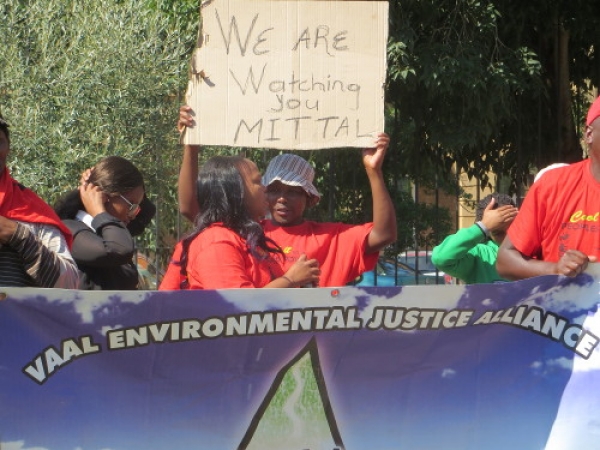The Centre for Environmental Rights (CER) collection (AL3299) at SAHA relates to CER's work in promoting transparency and accountability in environmental governance. CER’s work is aimed at testing and assessing the extent to which civil society can access environmental information held by regulators and private entities. The records included in this collection were released to CER and / or CER’s partner organisations in terms of the Promotion of Access to Information Act, 2000 (PAIA.)
The first series of documents in the collection consists of records of the ArcelorMittal (AMSA) Vanderbijlpark’s Environmental Master Plan 2003, as well as records relating to the Vaal Disposal Site in Vereeniging. The release of these records to the Vaal Environmental Justice Alliance (VEJA) in December 2014 demonstrates VEJA’s determination to hold AMSA accountable in their ongoing struggle against pollution in Steel Valley.
 When VEJA first submitted PAIA requests for the records in 2011-2012 on the basis that “…these documents are necessary for the protection of the section 24 constitutional rights and are requested in the public interest”, they were met with a blank refusal from AMSA who argued that the Master Plan was an internal working document which had become irrelevant over the years as laws changed. It was only in 2014, when the Supreme Court of Appeal (SCA) ordered AMSA to release the records to VEJA, that their enduring battle for access to the records came to an end.
When VEJA first submitted PAIA requests for the records in 2011-2012 on the basis that “…these documents are necessary for the protection of the section 24 constitutional rights and are requested in the public interest”, they were met with a blank refusal from AMSA who argued that the Master Plan was an internal working document which had become irrelevant over the years as laws changed. It was only in 2014, when the Supreme Court of Appeal (SCA) ordered AMSA to release the records to VEJA, that their enduring battle for access to the records came to an end.
The SCA judgment not only confirmed VEJA’s constitutional right to know the extent and impact of AMSA’s activities on the Vaal communities’ health and the environment, but their subsequent access to the records meant that they could now monitor these environmental impacts. The judgment was a further victory for environmental organisations in terms of requesting access to information from private bodies.
Developed by ISCOR from 2000 to 2002, the Master Plan consists of a series of specialist reports on the environmental and health impacts of the steel works, covering topics such as geology, ground water, surface water, consultation process, aquatic ecosystems, terrestrial ecology, land use and land capability, industrial water and air pollution, amongst others. Also included is the summary report compiled by AMSA in 2014 “to place the so-called Vanderbijlipark "Master Plans" and the progress made in terms of environmental management at the Vanderbijlpark Works into perspective”. The records are accessible on the SAHA website and print copies can be consulted in the SAHA reading room.
Of their decision to lodge copies of the released records with SAHA, CER says:
After more than a decade of struggling to obtain access to ArcelorMittal’s (AMSA) Master Plan records, the Steel Valley communities finally have access to them as a result of a court battle. These records show evidence of years of contamination and pollution by AMSA at its Vanderbijlpark steel plant. VEJA believes that these records should be publically accessible and available to all - as the Supreme Court of Appeal pointed out, “environmental degradation affects us all” and “there is no room for secrecy”. VEJA and the CER are happy to be working with SAHA – an organisation known for its work in promoting awareness of struggles for justice and access to information - to make this possible, so that everyone can easily access the Master Plan records online.
Dr Victor Munnik, of SWOP Institute, University of the Witwatersrand, who has done a PhD on this case and has worked closely with VEJA, says:
This is part of a long and ongoing struggle, spanning from Apartheid times, for access to information. It is fundamental that people are able to know how the environment and human health are impacted by industry. This is only the beginning and there is a lot still to be done.
The next series of documents from CER will include Eskom licences, compliance reports and health studies.
See inventory for the Centre for Environmental Rights (CER) collection (AL3299)
Visit the Centre for Environmental Rights (CER) website





 When VEJA first submitted PAIA requests for the records in 2011-2012 on the basis that “…these documents are necessary for the protection of the section 24 constitutional rights and are requested in the public interest”, they were met with a blank refusal from AMSA who argued that the Master Plan was an internal working document which had become irrelevant over the years as laws changed. It was only in 2014, when the Supreme Court of Appeal (SCA) ordered AMSA to release the records to VEJA, that their enduring battle for access to the records came to an end.
When VEJA first submitted PAIA requests for the records in 2011-2012 on the basis that “…these documents are necessary for the protection of the section 24 constitutional rights and are requested in the public interest”, they were met with a blank refusal from AMSA who argued that the Master Plan was an internal working document which had become irrelevant over the years as laws changed. It was only in 2014, when the Supreme Court of Appeal (SCA) ordered AMSA to release the records to VEJA, that their enduring battle for access to the records came to an end.